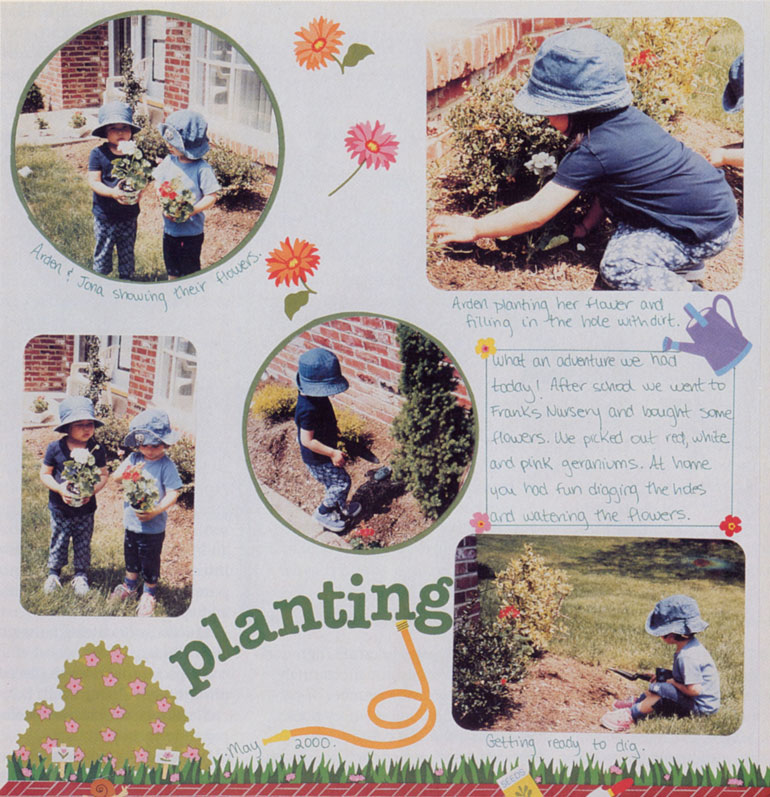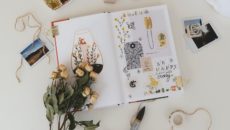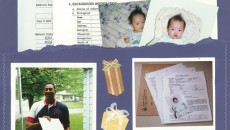How many of you have finished the adoption scrapbook you pledged to put together before you had your child? Raise your hands? Hmmm… I see a lot of downturned looks…
If you’re like me, maybe you’ve done a couple of quick photo albums of your adoption trip and the first year or two with your children. Thick envelopes of photos fill many boxes, and dozens of items you collected before and during your journey toward adoption-your home study, adoption conference programs, airplane ticket stubs, hotel menus, postcards, newspapers from the city your child is from-are in a closet. Maybe, like mine, they’re crammed into a shopping bag you got on your trip. Someday, I tell my daughter, Sadie, some day…
But as resources to create high-quality scrapbooks become increasingly available, a growing number of parents are assembling memory books. For many, this is a continuous process, because these scrapbooks represent an ongoing biography of our lives together. For our families, adoption scrapbooks create a sense of history, a sense of belonging. They assure our children that their history and heritage are valued, that their adoption story is worthy of chronicle and open discussion.
Getting Started
You don’t need to do anything fancy. Hallmark, for instance, markets adoption scrapbooks with labeled pages, but these have drawbacks. For one thing, as single mom Leslie Kizner found, they are often designed with two-parent families in mind. Fortunately, albums suitable to adoptive families are increasingly available through adoption book shops such as AdoptShoppe.com and Tapestry Books. (Look for Life Preserves, Adorable Adoptees, A Photo Album Story Book.)
Materials
It’s easy to become a scrapbooking addict. Once you begin, you’ll learn about fancy, chemically-treated papers, special scissors, and accessories to build your scrapbook. If you’re budget-conscious, you can get a how-to book (or free tips from a scrapbooking Web site), then shop at a discount store like Costco or Target.
A more direct way is to go to companies such as Creative Memories, which sells “photo-safe” albums that protect photographs from yellowing and preserve documents.
Elana Hanson, a Creative Memories consultant and mom of two daughters adopted internationally, advises parents to purchase albums with acid-free paper and special tools, such as
- scissors or cutting knives to crop photos,
- special adhesives to place the photos in an album, and
- stickers, die-cuts, and colored paper, to liven pages up.
Hanson has made adoption memory books for each of her daughters, chronicling the process leading to their adoptions, adoption trips, and milestone family experiences.
A scrapbook can also be the repository for precious documents. Shelley Reben, whose daughter Jessica is almost eight, inserted an invitation and photos from her baby shower, Jessica’s referral picture and medical report, photos of the adoption trip, plane tickets, the adoption contract, Jessica’s adoption announcement, and her Jewish conversion certificate. “The families in our travel group exchange Christmas photos. Each year we add the latest photos, so we have annual photos starting from when the kids were babies, and continuing to the present in our album,” says Shelley.
If you are an artist and compulsively organized, like Andi Lieberman, your single album will soon grow into a collection. Prior to adopting her daughter, Arden, Lieberman assembled pages of other waiting families, the family house and dog, and the preparation of Arden’s room. She even chronicled the process of buying baby supplies and packing the suitcase for travel, and she added a page of their itinerary. Then she made an album for each month of Arden’s first year home. “I take one roll of film per week,” Andi confesses.
When Andi gave birth to her second daughter, Jona, she created an album that begins with Jona’s delivery and then, as she had done for Arden, made one album per month for the first year. For subsequent years, she made family memory books.
Andi advises that if you don’t start a scrapbook right away, at least label your photos–with dates, names of places, and impressions–and put them in a box with dividers marking the month and year so you can find them when you’re ready to start. Keep the pages simple. “The importance of the album lies in the pictures and journaling, not all the decorative stuff!” she warns.
Multiple Roles for Adoption Scrapbooks
Lisa Wittorff, who has adopted domestically three times, has compiled “pre-adoption” books, usually called lifebooks, for each of her children, including descriptions of their house, neighborhood, friends, relatives, and important people in their lives. These lifebooks have been very versatile. The lifebook she made for her son Eli, now nine years old, includes photos of some of the foster families who cared for him prior to adoption, including their names and addresses and any other information she could obtain.
For Eli, who joined Lisa at age three, the lifebook has been useful “to help him understand the time before we became a family.” He also takes it to school to help tell his story when his class is covering units on families. Eli decorated the book with pictures that he drew.
For her five-year-old daughter, Nyasha, who was 16 months old at placement, Lisa prepared a book with laminated pages so that Nyasha could look at it without damaging it (remember your kids at that age!) during the month-long period of pre-placement visits before Lisa was able to bring her home.
When Lisa decided to adopt for a third time, she made what she calls an “advertisement album” to help her be matched with a baby. This scrapbook, bound and filled with family photos, was aimed at adoption professionals who could assist in her search.
For her children, Lisa planned lifebooks to cover their lives before their adoptions and to end when the adoptions were finalized. Since Eli’s finalization took just seven months, she decided to take his book through his first full year with her, and they named it Our First Year Together, A Year of Firsts. Nyasha’s finalization took 18 months, so hers covers that period. Aria’s lifebook will cover their first year together.
It’s Never Too Late
Although Leslie Kizner adopted her daughter Emily as an infant, she didn’t get around to starting the formal scrapbook until Emily had turned nine. (Until then Kinzer had used the Hallmark book and a few photo albums.)
Despite a hectic family life, Leslie makes steady progress through periodic “scrapbooking parties” organized by members of the Long Island chapter of New York Singles Adopting Children (NYSAC). These parties include dinner and playdates for the children. Says Leslie, “Knowing that we are going to get together encourages me to do some work at home on my book.”
Not long ago, Leslie and Emily made scrapbook pages from materials collected during a trip to Emily’s birthplace in San Antonio, which included a visit to the adoption agency Leslie used. Having an ongoing memory book project provides a link to the past, says Leslie. And, she adds, “my daughter enjoys it, so it’s a fun activity for us to do together, and we relive events as we do this.”
Scrapbooking can also be a terrific bonding experience. “The most unexpected thing that happened as a result of scrapbooking has been the making of lifelong friends,” says Andi Lieberman. “The first scrapbook class I had was with a group of adoptive families I’d met online. We didn’t really know each other except for the fact that we wanted to learn about making an adoption scrapbook. Now we are all close friends who shared each others’ adoption journeys. We continue to get together and of course share our children’s lives and albums!”



